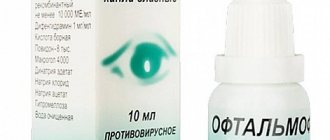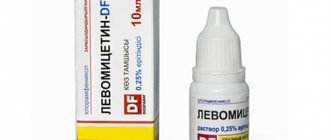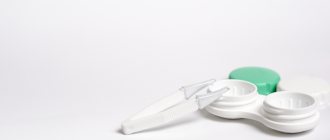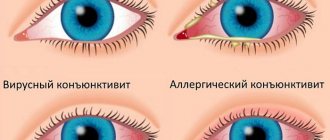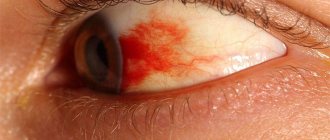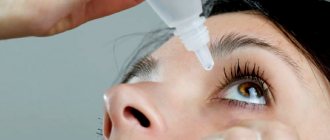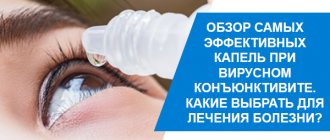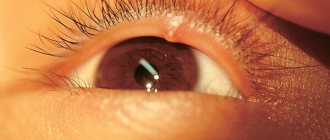Directions for use and dosage
To get the maximum effect from treating infections and not get negative consequences, doctors recommend adhering to a certain regimen of use. Here are some rules for using an antimicrobial:
- Before opening a bottle of medicine, be sure to wash your hands with soap.
- When there are detachable particles (for example, suppuration) at the edge of the eye (where the eyelashes grow), they are removed using an antiseptic. You need to moisten a piece of cotton wool with an antiseptic solution and remove excess from the eyelid.
- After this procedure, hands are washed with soap again.
- Next, the medicine is revealed.
- The patient throws his head back so that his eyes are directed to the ceiling.
- The lower eyelid is gently pulled down (a conjunctival sac is obtained).
- A few drops of the drug are added to the resulting “pocket”. You need to remember that the bottle with the solution is held slightly above the surface of the eye; the end of the dropper bottle should not touch the mucous membrane.
- It is advisable to keep the treated visual organ open for at least half a minute (you can hold the eyelids with your hands).
- Afterwards, it is recommended to blink a couple of times so that the sulfacetamide solution does not leak out.
- With a slight movement of your finger, you need to press on the outer corner of your eye so that the drops are thoroughly absorbed.
- The bottle with the bacteriostatic agent is tightly closed.
As a rule, the dosage of the drug is prescribed by the doctor on an individual basis. In accordance with the instructions for use, the dosage of eye drops looks like this: 1-3 drops 5-6 times a day. The duration of treatment depends on the specific disease.
For example, therapy for blenorrhea or conjunctivitis lasts up to 10 days, treatment for purulent diseases of the cornea - about two weeks or more. The amount of sulfacyl solution, the frequency of instillations and the duration of the treatment process do not depend on the age category of the patient.
True, Sulfacyl sodium eye drops for children and adults are selected according to the concentration of the medicinal solution. Newborn babies are prescribed 30% of the drug for preventive purposes (to avoid the development of purulent processes), 10% drops are used for the treatment of infectious eye diseases in children over 1 year of age, and 20% in adult patients. If parents have not found 10% for the child, then the use of a 20% solution is allowed.
In some cases, doctors recommend using drops to treat diseases of the nasal cavity. For example, the solution does an excellent job of treating a runny nose (rhinitis), which is caused by harmful bacteria.
The medication effectively stops the proliferation of bacteria on the nasal mucosa, thereby blocking infectious inflammation. It is recommended to use the medicine exclusively for mild forms of colds that provoke rhinitis.
The doctor prescribes a 10% or 20% solution 4 times a day, 3 drops. The course of treatment is 6-7 days. Sulfacyl sodium should be dripped into the nose of a child or an adult after rinsing the nasal passages with saline or slightly salted water.
During therapeutic measures aimed at treating eye infectious diseases, the following side effects may be observed:
- redness of the eyes;
- the appearance of swelling on the eyelids;
- local allergic reaction (sneezing, runny nose, tingling, etc.);
- pain, itching inside the eyes;
- whitish plaque on the eyelids (excess solution dried on the skin).
Sometimes we have to talk about a drug overdose. This occurs when the patient does not follow the instructions and puts eye drops more often than allowed. As a result, there is a noticeable burning sensation, pain in the eyes, a feeling as if there is a foreign body in the eyeball.
special instructions
There are a number of features that should be considered when using antibacterial drops:
- The medicine must not be used simultaneously with products that contain silver salts.
- When the bottle with the drug has already been opened, eye drops can be treated for no more than a month. After this period, you need to buy a new solution.
- It should not be used for therapy by those people who have a high level of sensitivity to sulfonylurea derivatives, furosemide, or thiazide diuretics.
- After each use of eye drops, the bottle should be tightly closed and stored in a dark place.
- To use the medicine for the first time, you need to carefully pierce a hole in the bottle. Before introducing drops into the eyes or ears, it is recommended to hold the bottle with the drug in your palms to warm it to body temperature.
Most doctors prescribe Albucid to pregnant women. Only eye drops should be used only after consultation with a physician. It has not been studied how the active component of the solution affects the fetus.
In childhood
The drug Sulfacyl sodium in the nose of infants and older children is allowed to be used in the complex treatment of inflammatory eye diseases of the infectious type. It is advisable to use 10% drops; they cause minimal discomfort and provide a positive therapeutic effect.
The anti-infective agent should not be used simultaneously with dicaine, novocaine or anesthesin; such symbiosis significantly reduces the therapeutic positive result. Salicylates, PAS, diphenine increase the toxicity of the drug to the eyes. Taking indirect anticoagulants with sulfacetamide increases the activity of the former.
The shelf life of eye drops is two years from the date of release. According to the instructions, it is recommended to store the medicine in a dark place, away from direct sunlight. An open bottle of the product can be used for no more than 4 weeks at a temperature of 8-15 degrees above zero.
The active ingredient of the drug is sodium sulfacetamide monohydrate. Additional ingredients: sodium thiosulfate, purified water, hydrochloric acid.
For those who are indicated for Sulfacyl Sodium eye drops, the instructions for use indicate that instillations should be carried out into the conjunctival sac. For adult patients, a dosage of 1-2 drops is prescribed.
The product is applied 5-6 times a day (every 4-8 hours). In childhood, a solution of 10 percent and 20 percent is indicated. To prevent the development of blemishes, 2 drops of the product are instilled into infants immediately after birth, and then 2 drops every 2 hours.
The medicine can also be used in ointments based on petroleum jelly 10-30% in case of blepharitis and eczema of the eyelid skin.
Instructions for use of Sulfacyl Sodium indicate that the duration of therapy directly depends on the severity of the disease. It is not recommended to use the medicine for longer without consulting a specialist.
We suggest that you familiarize yourself with the Causes and treatment of hypertensive retinopathy
In the case of gonorrheal eye diseases, combination therapy is prescribed. Instill a 30% solution or dust the affected area with powder; in addition, take the drug by mouth.
Infected wounds are treated using the powder.
The maximum single dosage for adults orally is 2 g, the maximum daily dosage is 7 g.
Before using the drops for the first time, the cap is screwed all the way down. A spike on the inside pierces a hole in the membrane. Before use, you need to hold the bottle in your palm for a while to warm the product to body temperature.
In case of overdose, redness, swelling of the eyelids, and itching are possible. Then they continue to use a lower concentration of the drug or completely discontinue the drug.
The composition of the medicine includes only 3 components - these are:
- hydrochloric acid;
- special purified water;
- sodium thiosulfate.
The dosage of the drug for adult patients depends on the type of disease and the nature of its course.
Eye treatment is carried out as follows:
- wash your hands with soap;
- drop 1 drop of Albucid into each eye;
- after 20-30 seconds, remove excess medication using sterile cotton wool, moving from the outer corner of the eye to the inner one;
- if a specialist has prescribed 2 drops into the eyes, then repeat the above steps after 4-5 minutes;
- Wash your hands with soap.
Remember that cotton swabs for wiping off excess solution must be individual for each eye in order to avoid additional infection.
In cases where an adult wears contact lenses, it is best to abandon them for the period of course treatment.
The thing is that before carrying out the instillation procedure, they must be removed, and they can only be put back on after half an hour, which is a completely inconvenient moment due to the frequency of use of the drug.
When instilling a significant volume of Sulfacyl sodium eye drops, significantly exceeding the recommended therapeutic dosage, negative local reactions may appear or intensify. In this case, the eyes are washed with a significant volume of running water, as well as symptomatic therapy prescribed by the doctor.
The main component of the drops is sodium sulfacetamide in the form of monohydrate (100 mg, 200 mg or 300 mg in 1 ml of solution). The solution also contains auxiliary compounds - hydrochloric acid, sodium thiosulfate, purified water.
Drops are available in three dosages - in the form of 10%, 20% and 30% solution, in bottles of 5 ml or 10 ml, dropper tubes of 1 ml or 1.5 ml.
The dosage of the drug, frequency and duration of treatment are selected by the doctor individually depending on the type of disease, the severity of the inflammatory process, and the age of the patient.
According to the instructions for Sulfacil sodium, adults need to instill 1-3 drops of a 30% solution every 4-8 hours (4-6 times a day). As the severity of the symptoms of the disease decreases, the frequency of use of the drops is reduced.
It is recommended to instill the eye first, in which the symptoms of inflammation are less pronounced. But even if the inflammation is one-sided, it is recommended to apply drops to both eyes, since the infection is easily transferred from one side to the other.
How to treat stye on the upper eyelid
In order to decide how to treat stye on the upper eyelid, you need to consult an ophthalmologist. During an in-person examination, a doctor specializing in the treatment of diseases of the eyeball and its appendages will make a diagnosis and prescribe medications for a specific case.
The specialist will describe in detail how to treat barley, and will explain popularly that this is a local inflammation, a small boil that arises as a result of penetration of pyogenic microflora into the eye area, which provokes an infectious process.
What contributes to infection
At the onset of the disease, internal styes on the upper eyelid appear suddenly; usually the entire eyelid swells, and not a specific area at its edge. Swelling of the skin of the eyelid and conjunctiva occurs. The inner side of the eyelid is affected.
An abscess forms. After its maturation and spontaneous opening, purulent mass and dead tissue flow into the conjunctival sac. The pain immediately decreases sharply and inflammation subsides.
In medical circles, internal stye is called meibomitis. The maturation process is often accompanied by the following symptoms: headache, increased body temperature.
The causes of infection may be:
- weakening of the immune system,
- diabetes;
- dental disease;
- tonsillitis;
- drafts;
- overwork;
- depressive states;
- hypothermia of the body.
Stye inside the upper eyelid can be complicated by orbital phlegmon, abscess, or meningitis. In the acute form of meibomitis, damage to the eyelid is observed not at the edge, as with barley, but in the depths of the cartilaginous tissue, which can be observed when the eyelid is everted.
Treatment methods
At the initial stage, when the eyelid is only slightly red, if timely measures are taken, there is a chance to avoid the growth of barley on the inside of the upper eyelid.
In order to prevent the spread of the disease or its resumption, a 20% solution of sodium sulfacyl should be instilled into the eye 4-6 times a day, and tetracycline or erythromycin ointment should be placed in the conjunctival sac at night.
For quick spontaneous opening of barley or for its complete resorption, dry heat has a beneficial effect.
- To warm stye under the eyelid, you can use a hard-boiled chicken egg, warm, wrapped in a napkin and applied to the eye.
- The clinic may prescribe a red light, UHF.
- Hot and cold compresses, applied alternately, promote rapid ripening of the stye head and rapid release of the contents.
After opening, tetracycline ointment, synthomycin emulsion or albucidal ointment is applied to the inner surface of the eyelid 2 times a day. If several styes develop, merging into one, then the person’s general condition worsens, the temperature rises, and the submandibular and parotid lymph nodes swell.
In this case, treatment with sulfonamide drugs or modern antibiotics (Tsiprolet or Tobrex), vitamins, and yeast preparations is indicated. If internal stye appears on the eye, it is forbidden to wear contact lenses or use cosmetics during therapy.
Traditional methods
- Traditional medicine recommends applying lotions and compresses to the sore eye with a tincture of calendula and valerian flowers, diluted 10 times.
- Aloe is also used: you need to cut off the leaf, wash it, squeeze out the juice, dilute it with cold water 1:10.
- For barley, it is recommended to take 7 small yellow tansy flowers 4 times a day with plain water.
If stye bothers you on the upper eyelid, treatment with fresh tansy flowers will help get rid of it and prevent recurrences. Warm lotions made from eyebright tea mixed with an equal amount of chamomile help. Treatment must be continued until the stye under the eyelid matures and its contents flow out.
Meibomite and meibomian cyst
Sometimes the infiltrate does not resolve and a small compaction remains after the stye; this painless formation, no larger than a pea, is called a meibomian cyst. It is safe, but it is noticeable, there is a disturbing cosmetic defect and, in addition, an unpleasant sensation, as if something had got into the eye.
In this case, the only effective method that provides a comprehensive answer on how to treat stye on the eye in a specific situation is surgical removal. This is a quick, painless operation performed under local anesthesia.
Acute meibomitis is prone to frequent relapses, which are usually observed against the background of reduced immunity and general weakening of the body. In most cases, acute meibomitis degenerates into chronic and is almost always accompanied by conjunctivitis.
To the question often asked to doctors, how to quickly cure barley, there is a clear answer that there will be no quick treatment. It will take at least 8 days until the infiltration completely resolves and subsequent soft scarring occurs. It is important to prevent the development of chalazion, a chronic inflammation of the cartilage around the meibomian gland.
Video
Indications for use
Sulfacyl sodium is an eye drop that is highly safe. The only contraindication to their use is individual intolerance to the main or auxiliary components included in the solution.
Typically, intolerance to sulfacetamide is observed in patients with hypersensitivity to Diacarb, Glibenclamide, Furosemide, Hydrochlorothiazide.
Eye drops are used for gonorrheal eye diseases, conjunctivitis, blenorrhea, purulent corneal ulcers, blepharitis and other eye diseases. The drug can be used by both children and adults, including for the purpose of preventing blenorrhea in infants. In the case of purulent processes, it stops them and accelerates the healing of the cornea.
Prescribed for the treatment of streptoderma and staphyloderma, infections caused by Escherichia coli.
The medicine can be used orally in the case of colibacillary urinary tract infections, mastoiditis, puerperal sepsis and other infectious diseases.
This product should not be used if you are hypersensitive to its components.
That is, it does not allow the reproduction of certain classes of harmful microorganisms, namely:
- chlamydia;
- gonococcus;
- streptococci;
- shigella;
- chlamydia;
- toxoplasma;
- pneumococcus;
- coli;
- actinomycetes.
Eye drops have only a local antiseptic effect; there is no absorption of the drug. And it can enter the blood supply system in minute concentrations and only through the inflamed membrane of the eyeball. Among the indications for the use of sulfacetamide, the following cases are distinguished:
- in the presence of conjunctivitis;
- purulent ulcerative lesions of the cornea;
- blepharitis;
- keratitis;
- inflammation of the eye in the form of styes;
- to prevent inflammation in cases of eye contamination with dust, sand and other substances;
- for gonococcal and chlamydial eye lesions in infants;
- as a prophylactic agent after surgical interventions;
- in the treatment of gonorrheal diseases of the eye apparatus.
The possibility of its use for children and adults should be discussed based on the available concentration. If the solution is 30%, then it can only be intended for an adult patient, but for the treatment of diseases in children, the content of sodium sulfacyl in the solution should not exceed 20%.
It is necessary to instill the medicine into both eyes, despite the fact that only one may be affected, 2 drops 3 to 10 times a day, depending on the instructions of the ophthalmologist. If the patient's condition improves, the number of times the drug should be used should be reduced.
Tips for use
To make the use of Albucid in the treatment of barley as effective as possible, you must follow the following tips:
- Before use, be sure to read the instructions, especially carefully study the dosage of use and contraindications;
- If you use lenses, they must be removed before instilling Albucid, since the drug can impair their transparency. It is recommended to wear lenses no earlier than half an hour after the procedure. It is advisable to avoid contact lenses for the entire period of barley treatment, due to the fact that they inhibit the healing process;
- Before the procedure of instilling drops, you must wash your hands, preferably using antibacterial soap, then wipe them dry. To avoid introducing any negative microorganism into the affected eye;
- When instilling, you should pull back the lower eyelid so that the drops are more easily located on the conjunctival sac;
- Treatment with drops should not exceed two weeks;
- Do not store an open bottle;
- The medicine is valid only for 28 days from the date of opening;
- Drops should be instilled, having previously warmed them to body temperature; it is strictly forbidden to drop cold drops into the eyes (the drug should be stored at a temperature no higher than 15 degrees, respectively, this temperature is observed only in the refrigerator).
In what cases are eye drops contraindicated?
Sulfacyl sodium should not be used by people who have allergic reactions to the following substances:
- diuretics;
- carbonic anhydrase;
- sulfonylurea;
- inhibitors.
And also in the presence of individual intolerance to any of the components of this medicinal product.
In any case, even if the patient has not previously had allergic reactions, and after using the drug his condition has sharply worsened, then it is necessary to urgently seek qualified medical help.
At the moment, in addition to albucid, which is familiar from childhood, there are a number of drugs that are its analogues, these include:
- sodium sulfacyl MEZ;
- sulfacetamide;
- sulfacyl sodium bufus;
- sodium sulfacetamide;
- sulfacyl sodium Vial.
The drugs are not recommended for children under 2 months of age, as well as for nursing mothers and during pregnancy. All manufacturers refer to the fact that the drug has been poorly studied.
We suggest you familiarize yourself with Oftalmoferon for conjunctivitis in adults: how to use it
There are also differences in the side effects column; symptoms such as:
- sharp burning sensation;
- allergic reaction;
- profuse lacrimation;
- sting.
Patients who experience at least one of the above symptoms are advised to immediately stop using the medication and consult a qualified healthcare professional.
Adults, when buying an analogue of the drug sodium sulfacyl at a pharmacy, should first study the attached information in the package, since it may not be suitable for a child of age or an adult who is prone to allergic reactions to medications.
Most importantly, neither sodium sulfacyl nor its analogues should be used after the expiration date, and when opening the bottle, it is best to write the date on it, since it will be intended for use only within a month.
Pharmacodynamics and pharmacokinetics
The Pharmacopoeia indicates that the formula of Sodium Sulfacyl is CsHgSaNaOsS-b^O. INN – Sulfacetamide. The recipe in Latin will contain the name Sulfacylum-natrium.
Eye drops inhibit the absorption of PABA and also prevent the synthesis of PABA-containing growth factors of microorganisms.
The medicine is characterized by antibacterial properties. It acts on streptococci, gonococci, E. coli, chlamydia, pneumococci, actinomycetes.
An aqueous solution of Sodium Sulfacyl has a slightly alkaline reaction, which allows it to be instilled into the conjunctival sac of the eye.
Treatment of barley in children
Albucid, or sodium sulfacyl, is widely used in pediatrics. Therefore, doctors often recommend it in the treatment of barley. For small patients, drops of a 20% sulfacetamide solution are optimal. They will have a more gentle effect on the child’s eyes - there will be less discomfort of various types after instillation - burning and tingling.
We recommend! To treat eyes without surgery, our readers successfully use a proven method. Having carefully studied it, we decided to offer it to your attention.
Side effects
In most cases, the use of drops does not cause any side effects on the human body.
But in rare cases, minor deviations from the norm may occur in the form of:
- redness of the eyes;
- itching;
- swelling of the eyelids.
If any of the above symptoms occur, you should consult your doctor. He must either replace the drug or prescribe sodium sulfacyl with a concentration lower than that of the solution used.
In some cases, the drug has local side effects, manifested by:
- eye irritation;
- redness;
- swelling;
- itching.
Typically, eye drops are well tolerated, and adverse reactions more often occur with an overdose of the drug. Along with the listed side effects, an overdose may cause severe burning, a sensation of a foreign body in the eyes, and lacrimation.
In some cases, when taking the drug, tissue irritation may occur, including redness, swelling of the eyelids and itching. When using the medicine internally, allergies and dyspeptic disorders are possible.
Drug treatment
Drug therapy consists of taking various medications. These can be drops and ointments that are used topically, or preparations for oral administration - tablets. These medications relieve all symptoms of the disease, eliminate inflammation and fight the causative agent of barley.
Pills
To eliminate the infectious disease, antibacterial tablets and antibiotics are used. The most commonly used drugs are:
- Ofloxacin. This is a broad-spectrum antimicrobial drug. Applicable after 18 years of age;
- Amoxil. This is a broad-spectrum antibiotic. Prescribed for both adults and children.
Tablets are prescribed for complications or an advanced form of the disease, when drops and ointment are no longer sufficient.
Ointments
Ointments, unlike drops, have a rather thick consistency. When placed behind the lower part, such drugs greatly impair the patient’s vision. For this reason, all ointments are used only before bedtime. The most effective and versatile ointments that are used for various eye diseases are the following:
- Tetracycline ointment. A gentle remedy for the treatment of barley. In rare cases, it causes side effects: nausea, inflammation of the mucous membrane in the oral cavity, loss of appetite and dysbacteriosis;
- Erythromycin ointment. An effective broad-spectrum antimicrobial agent. Most often used if the stye does not go away for a long time.
Ointments are used as an adjuvant if the patient is seriously ill with the disease, or if complications begin.
Advantages and effects of drugs in drops
Drops can be used when the first signs of stye appear. If treatment is started in a timely manner, then taking other forms of medications will simply not be necessary. Unlike ointment, drops are quite easy to use.
This can be done throughout the day, but it is impossible to exceed the dosage, since the eye cannot absorb more than a certain volume of liquid. In addition, the drops begin to act quite quickly, as they are absorbed directly into the small blood capillaries located in the eye.
IMPORTANT! All medications must be prescribed to the patient by a doctor. Even if the drug is sold without a prescription, it should not be used independently without the appropriate recommendations of an ophthalmologist.
Sulfacyl Sodium for children
Perhaps one of the most common childhood diseases, especially in the summer, is conjunctivitis.
The very first assistant in the fight against this pathological process is sodium sulfacyl. It relieves the inflammatory process and prevents the development of pathogenic microorganisms.
Albucid containing no more than 20% of the active substance is used to treat children. Experts most often prescribe 1-2 drops of solution in each eye 3 to 5 times a day. As the patient's condition improves, the number of uses may decrease.
When treating a child with sodium sulfacyl, you should remember several basic rules:
- The medicinal solution must be fresh. This is the only way to ensure maximum effectiveness of the drug.
- The instillation procedure should only be carried out by an adult. This is necessary to avoid additional eye injury and prevent an overdose.
- The procedure must be carried out in a sitting or lying position. For children under 5 years of age, it is best to apply eye drops while lying down, and at this moment they must be held.
- Albucid is first pipetted or using an existing dispenser into the healthier eye. This action must be carried out in this way, because after the medicine enters the conjunctival sac, the child begins to actively rub his eyes and can easily transfer the infection to a less infected one.
- The hands of an adult who is treating a child’s eyes must be washed with soap both before and after the procedure.
Newborns should be discussed separately. To avoid the development of blenorrhea, sodium sulfacyl is instilled in them in the first minutes of life, and then after 1-2 hours the procedure is repeated.
Subsequently, if the baby does not have any special indications for the use of this drug, then it is not used until the child reaches one year of age.
Sulfacyl Sodium for children is used in a dosage of 2-3 drops (20% solution). The child should be in a sitting or lying position. You should carefully open your eyelids and drip the medicine. It is recommended to start from the place where the inflammation is less pronounced.
In case of acute otitis media, the drug is instilled into the ears. It can be diluted in boiled water 2-4 times.
How to use the drops
Drops should be used for 4-5 days in a row, but no longer than 10-12. Before starting the instillation procedure, you must thoroughly wash your hands with an antibacterial agent and follow these instructions:
- Remove the cap from the bottle and do not touch the skin of your hands, face, eyelashes or other objects with the pipette, as this will lead to the entry and proliferation of bacteria inside the bottle and on the mucous membrane of the eyes, which will only aggravate the patient’s condition;
- With one hand, gently pull down the lower eyelid to create a “pocket” between it and the eye;
- With your other hand, apply the required number of drops. Try to get closer to the outer corner of the eye so that as much of the medicine as possible remains on the mucous membrane;
- After instillation, the patient should close his eyes and move them slightly under closed eyelids for 30-60 seconds to distribute the drug more evenly.
After completing the procedure, it is necessary to remove excess droplets by blotting them with a cotton pad, and wash your hands again with antibacterial soap. If you accidentally instilled more medication than is written in the instructions, you should not worry, as the excess drug will come out along with the tear fluid.
If the doctor has prescribed several drops at the same time, they should be used with an interval of 20-30 minutes so that each drug has time to penetrate into the affected eye tissue and begin to act. The order of use of different drugs is determined by the ophthalmologist.
Useful video
List of drops for barley: ointments, folk treatment:
The use of drops for conjunctivitis, barley
The main sign of a weakened immune system is Parasites that live in your body
Think about it if you have:
- weakened immune system
- drowsiness
- frequent fatigue
- depression
- headaches, as well as various pains and spasms in the internal organs
We recommend that you carry out an antiparasitic cleansing of your body. How to do this read here
Adults, as well as children, can suffer from conjunctivitis. This disease is characterized by redness of the white part of the eyeball, severe itching and purulent discharge.
You should not hope that the disease will leave the patient on its own; in addition, if a person does not follow the rules of personal hygiene, then other family members can become infected from him.
Sodium sulfacyl can help cope with pathology in short periods of time, of course, with the exception of the fact of individual intolerance to the drug.
Treatment is carried out as follows: first, the drug is used up to 5 times a day. 1-2 drops should be instilled into each conjunctival sac, depending on the severity of the disease.
After a noticeable improvement occurs, the number of times the drug is used is reduced to 3. Typically, the therapeutic course is from 5 to 7 calendar days.
Another fairly common ailment among the adult population is barley. From stye, the inflamed eyelid turns red and swells quite severely.
It is possible to relieve the inflammatory process with the help of albucid. Ophthalmologists recommend using it for this pathology 5 to 6 times a day, instilling 1-2 drops into each conjunctival sac.
The main rule is to have clean hands and remove excess medication from the eyelids and eyelashes with a cotton pad. Because after a certain amount of time, sodium sulfacyl crystallizes, thereby causing additional itching in the eye area.
We invite you to familiarize yourself with Retinal dystrophy - what it is and treatment methods
A little about the disease
Barley is an acute inflammatory process that occurs in the area of the sebaceous or meibomian gland in the eyelid area or at the roots of the cilia. Barley can lead to the appearance of a purulent abscess and other serious complications. The first signs of an impending disease are:
- Itching, redness and slight tingling of the eyelids;
- Swelling of the eyes;
- Painful sensations when touching the eyelids.
If the process of development of barley is not stopped at the first stage, the body’s immunity weakens even more, and new symptoms appear:
- A tubercle forms on the eyelid, similar to a small grain;
- Pain, pressure, and shooting appear inside the stye;
- The tubercle begins to increase in size;
- There is a feeling that fluid has accumulated inside the tubercle;
- It hurts to blink and open your eyes;
- Photophobia and severe lacrimation appear;
- The temperature and general malaise rise.
Most often, barley affects people with weakened immunity and impaired metabolism. The cause of the disease can be severe hypothermia, frequent stress, great physical and mental stress, colds, vitamin deficiency, as well as failure to comply with personal hygiene rules, dust and other foreign objects getting into the eye.
Sulfacyl sodium Solopharm, DIA
At the moment, when a patient contacts a pharmacy with a request to sell him sodium sulfacyl, the pharmacist asks the question: which one?
The thing is that there are several manufacturers of this drug. And many patients are at a loss as to which drug is best.
In addition to ordinary albucid, which can be produced by Moscow or Kurgan, there are sodium sulfacyl DIA and Solopharm.
Additional occurrences in the name indicate not only the brand and city of the manufacturer. There are some differences in these medicines.
Manufacturers make allowances for the fact that drugs of this class should not be used by children under two months of age, as well as by pregnant and nursing mothers.
In addition, it should be remembered that sodium sulfacyl DIA is available only in a 10 or 20% solution, which can significantly affect the treatment process for an adult, especially if up to this point he has always used a 30% solution.
In this case, of course, there is no need to talk about the effectiveness of the drug; the significance of the course of treatment will depend on the number of times the drug is used. The doctor must focus the patient’s attention on the percentage of the substance in the prescribed drug.
Sulfatsil Belmed
Sulfacil Belmed - eye drops consisting of the following components: specially purified water, sodium sulfacetamide and sodium thiosulfate.
The use of the drug is indicated in cases of detection of one of the following pathological processes:
- gonorrheal eye diseases;
- conjunctivitis;
- purulent ulcers of the cornea;
- prevention of blenorrhea;
- blepharitis;
- viral eye infection;
- fungal infection of the eyes.
Each drug, in addition to its indications for use, also has contraindications. Among them, individual intolerance to any of the components of the composition should be specially noted.
Methods of using this drug and its dosage depend on the patient’s problem:
- in cases of blepharitis, treatment is carried out from 6 to 8 times a day, when the patient’s condition improves, the frequency of use is reduced to 3-4 times;
- in the presence of conjunctivitis, the drug is instilled every 60 minutes, excluding sleep time, for 2 days, after which it is reduced to 6 times a day;
- Gonorrheal eye diseases are treated on a daily basis for 5-6 weeks, instilling 2 drops into each conjunctival sac 6 times a day.
The duration of the therapeutic course should be regulated only by a qualified specialist.
With frequent use of Belmed sulfacyl, the patient may experience overdose symptoms, which include:
- redness of the eyes;
- itching;
- swelling of the upper and lower eyelids;
- irritation of the mucous membrane.
If at least one of the above factors is detected, it is necessary to switch either to a drug with a lower concentration of the active substance, or to completely stop using it and seek help from specialists.
Criteria for choosing drugs
Any drug is selected in accordance with the patient’s condition and his individual characteristics: sensitivity to the components of the drug, allergies, skin condition, etc.
Antibacterial medications provide the best effect in the treatment of stye, as they prevent bacteria from multiplying and reduce discomfort in the inflamed eye. Antibiotics are used for various complications or advanced disease.
IMPORTANT! Any drug is selected individually by the attending physician, based on the patient’s condition and diagnostic results.
Interaction
When combining eye drops with other medications, it is important to consider drug interactions. The active components of drugs enter into chemical reactions, as a result of which the strength of their therapeutic effect changes or adverse reactions worsen.
- When Sulfacyl Sodium is combined with Anestezin, Dicaine, Novocaine, its antibacterial activity is reduced.
- The toxicity of Sulfacyl sodium increases when used simultaneously with salicylates, para-aminosalicylic acid, and Diphenin.
- With simultaneous treatment with Sulfacyl sodium and indirect anticoagulants, their pharmacological effect is enhanced.
It is prohibited to use zinc sulfate, alkaloids, and silver-based preparations simultaneously with sodium sulfacyl. Also, you cannot combine albucid with drugs that have an acidic reaction.
If you need to take other drugs in combination with Sulfacyl Sodium, you should consult your doctor.
The bacteriostatic effect of the drug is reduced when combined with Novocaine, Anestezin and Dicaine. And its toxicity increases when interacting with Difenin, salicylates and para-aminosalicylic acid.
Drops should not be used together with salts of some alkaloids, with agents containing silver salts, with zinc sulfate, as well as with acids and substances that have an acidic reaction.
Negative pathological reactions
In general, Sulfacyl sodium eye drop solution is quite well tolerated when used correctly. Sometimes, against the background of its use, it is possible to develop local pathological reactions in the form of irritation (redness of the eyes, burning, sensation of a foreign body).
Somewhat less often, an allergic reaction may develop with a rash on the skin around the eyes and itching. Usually, negative pathological reactions (except allergic manifestations) disappear on their own and do not require discontinuation of the drug.
Special recommendations
Before starting to use Sulfacyl sodium eye drop solution, it is important to carefully read the instructions for the medication. Persons who have hypersensitivity to drugs of the pharmacological group thiazide diuretics and sulfonylureas may also have individual intolerance to sulfonamides.
In pharmacies, a solution of eye drops is available without a prescription. If you have any doubts about the use of the medicine, it is recommended to consult a medical specialist for advice.
Therapy rules
The standard treatment regimen for stye in children and adults includes the use of eye drops. They help quickly relieve inflammation and prevent the spread of infection to the healthy eye.
Most drops prescribed for barley contain antibiotics, so their use should be monitored by an ophthalmologist, especially when it comes to treating a child or a pregnant woman.
In order for the medicine to bring maximum benefit, it should be used correctly:
- Before manipulations, you need to wash your hands with soap;
- patients need to remove contact lenses, women need to remove makeup;
to warm the medicine to room temperature, you should hold the medicine in your hands for several minutes;- the patient needs to slightly pull back the eyelid of the inflamed eye, look up or to the side;
- after instillation, it is recommended to lie down for 15-20 minutes;
- During the treatment of barley, it is forbidden to squeeze out pus or pierce a vesicle with purulent contents: the infection will spread to the healthy eye, or complications will arise.
Barley therapy requires careful adherence to hygiene rules and other precautions:
- do not touch your eyes with dirty hands;
- use only your own cosmetics;
- wash all cosmetic instruments in an antiseptic solution;
- Before going outside in windy or frosty weather, you need to put a bandage on your eye.
If on the 7th day after the onset of the disease the purulent head has not opened, the compaction interferes with normal vision, and causes severe pain, you should consult an ophthalmologist.
The doctor will remove the pus on an outpatient basis, after which there will be no scars left on the eyelid.
Most often, antibiotic drops are prescribed to treat barley. Antibacterial eye products are divided into several medicinal groups, depending on the type of active substance. So, they are used:
- Aminoglycosides - Tobrex, Gentamicin.
- Fluoroquinolones - Floxal, Signicef.
- Levomycetin drops.
Separately, among the eye drops for barley, it is necessary to highlight sulfonamide drugs (Albucid). Antiseptic solutions (Miramistin) may also be prescribed for instillation. It is advisable that drops for the treatment of stye on the eye are selected by a doctor. The specialist determines the drug for a particular patient, taking into account his age, expected tolerability of the drug, and possible side effects.
Price of Sodium Sulfacyl, where to buy
Eye medicine in the form of a solution is sold without a doctor's prescription, so it can be bought at a regular pharmacy kiosk or ordered from an online store from a catalog. When purchasing a medicine, you should definitely pay attention to the expiration date of the drops and the integrity of the packaging. Below is a table with the approximate price of the product in pharmacies.
The price of Sulfacyl Sodium eye drops 20% is about 50 rubles. In some pharmacies the cost of this product reaches 85 rubles. The average price of Sulfacyl Sodium in Ukraine is 10 hryvnia.
